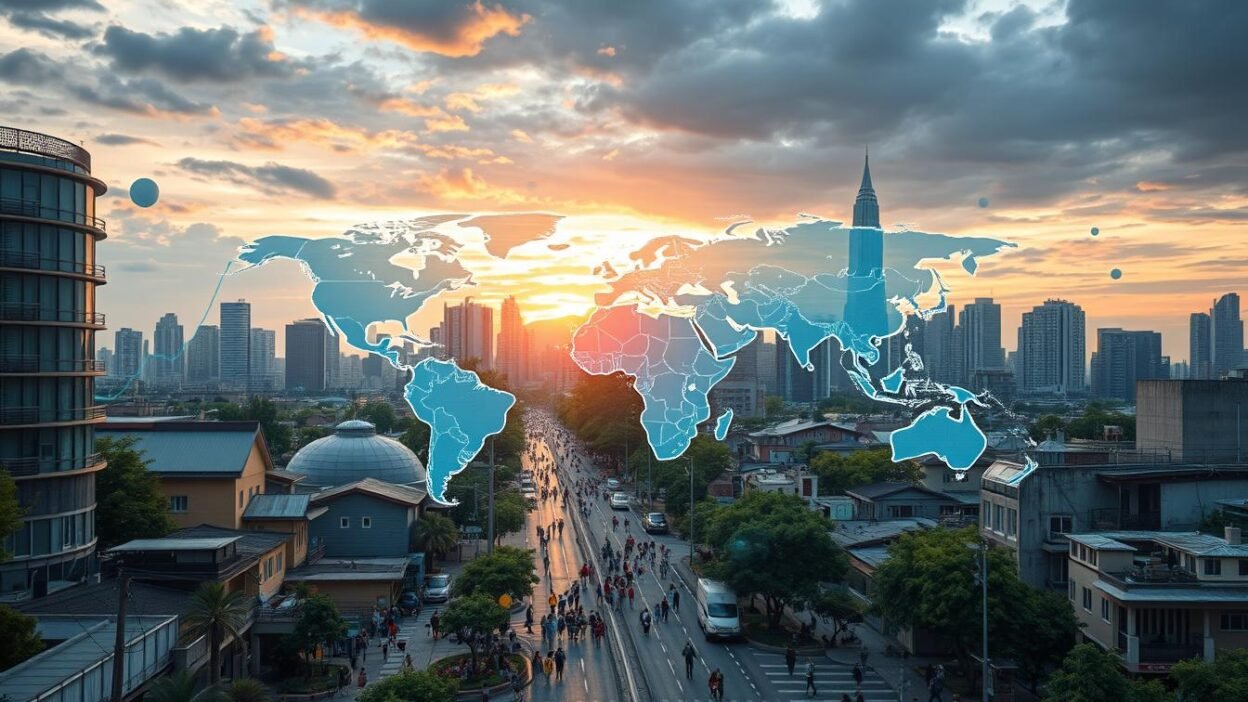How will demographics change global societies by 2050? The answers blend data, policy, and human behavior. The United Nations and INED predict a world where cities and older populations will change economies and nature. This article looks at how new research in demographics is guiding strategies to tackle these issues.
Population studies, starting with centuries of censuses, now use advanced tech like big data and GIS mapping. Old methods and new tools help forecast trends in education, healthcare, and resources. But, there are big questions about privacy and politics in this field.
Preparing for the UGC NET exam can be a daunting task, but with the right resources, candidates can navigate the process effectively. Websites like MyJRF provide a comprehensive platform for aspiring educators, offering specialized guidance for UGC NET Paper 2 preparation and essential tips for acing UGC NET Paper 1. Additionally, understanding the revised syllabus provided by UGC is crucial for a targeted study approach. For official announcements and updates, candidates should regularly visit the UGC NET NTA portal, while the UGC’s job section and the main UGC website are invaluable for post-exam opportunities and academic resources. With these tools, candidates can maximize their preparation and set themselves up for success. Preparing for Paper 1 and UGC NET Paper 2 Education requires a strategic approach with quality resources. UGC NET Education aspirants can access structured video lectures that cover essential concepts comprehensively. For an in-depth understanding, check out teaching aptitude videos and research aptitude guidance to strengthen your foundation. Additionally, higher education system topics and communication skills preparation are crucial for scoring high. Explore logical reasoning tutorials and mathematical reasoning lectures for better problem-solving skills. Enhance your exam strategy with people, development & environment lessons and ICT in education modules. For previous year papers and practice sessions, explore mock test videos and exam strategy tips. Stay ahead in your preparation with teaching methodology insights and subscribe to Educators Plus for expert guidance.
Key Takeaways
- Global population studies now prioritize interdisciplinary collaboration to solve 21st-century challenges.
- United Nations projections show a projected 9.8 billion people by 2050, altering urban planning and sustainability efforts.
- Technological innovations are revolutionizing data collection but raise critical ethical questions.
- India’s demographic profile positions it as a key case study for balancing growth with equitable development.
- Policy decisions informed by population studies directly impact poverty reduction and public health outcomes.
Understanding the Basics of Population Studies
Population studies look at human populations through demographics. They analyze size, distribution, and trends. This field combines sociology, statistics, and geography to tackle global challenges.
Modern research uses historical patterns and new tools. It gives insights into how societies evolve.
Definition and Scope
Demographics is about data on human populations. It includes:
- Birth and death rates
- Migration patterns
- Age and gender distributions
- Educational attainment levels
The Demographic Transition Model explains population changes. It helps in making policies for healthcare, education, and urban planning.
Historical Context
Early demographic work started with censuses. Here are key moments:
| Year | Event | Impact |
|---|---|---|
| 1790 | First U.S. Census | Started systematic data collection |
| 1948 | UN Statistical Commission founded | Made global demographic research possible |
| 1960s | Demographic Transition Model formalized | Helped in understanding development studies |
“Demographic trends shape the foundation of sustainable development,” noted the UN Population Division in its 2023 report. Early methods like headcounts evolved into advanced analytics tracking everything from fertility rates to climate migration.
Today, we use both traditional surveys and AI for projections. This ensures we can tackle 21st-century challenges effectively.
The Importance of Population Studies in India
Population studies in India are very important. The country is the second-most populous in the world. Understanding population trends is key for growth.
Recent United Nations projections show India could be the most populous by 2023. This makes it urgent to have policies based on evidence.
Economic Impact
India’s economy is linked to population trends. These trends affect labor markets and productivity. Rapid urbanization and a young population offer both challenges and chances.
- Demographic dividend: A large working-age population could boost GDP with quality education and jobs.
- Resource allocation: Data helps focus investments in healthcare and infrastructure.
- Economic inequality: Tracking population shifts shows income and service access gaps.
Social Implications
Social stability depends on population trends in education, healthcare, and gender equity. For example:
- Educational access: More youth means schools and vocational training need to grow.
- Healthcare demands: Aging and urban migration put a strain on facilities, needing targeted help.
- Gender dynamics: Fertility and workforce data help bridge gender gaps.
“India’s population is not just a number—it is a mosaic of opportunities and challenges requiring rigorous analysis.” — United Nations Development Programme, 2023
By using population trends in policy-making, India can turn challenges into opportunities. This ensures fair development and tackles the complexities of a changing demographic.
Key Demographic Trends in the 21st Century
Global demographic shifts are changing societies and economies. Three trends are driving human population growth. These are urbanization, aging populations, and migration patterns.
Urbanization Rates
Urban areas are growing fast. By 2050, 68% of the world’s population will live in cities, says the UN. India’s cities will see a huge increase in population by 2031.
This growth puts a strain on infrastructure and housing. It creates both innovation hubs and informal settlements.
- India’s megacities: Delhi and Mumbai face overcrowding amid rising rural-to-urban migration.
- Environmental impact: Urban sprawl threatens ecosystems and water resources.
Aging Population
Life expectancy gains have changed age structures. Japan’s population over 65 is now over 29%. Italy’s median age is 45.
These trends put pressure on pension systems and labor markets. India’s young workforce is a contrast but needs strategic planning to grow.
“Aging populations redefine social policies, requiring intergenerational equity frameworks,” states INED’s 2023 report.
Migration Patterns
Forced and voluntary migrations change demographics. Conflict-driven displacement, like Syria’s 6.8 million refugees, adds to regional instability. Economic migrants from South Asia to Gulf states show labor market dependencies.
These flows change cultural identities and remittance economies.
These trends show the need for adaptive governance. Policymakers must tackle urban planning, elderly care, and migration frameworks. They need to align human population growth with sustainable development goals.
Population Studies and Sustainable Development Goals
Population geography helps link demographic research with the UN’s Sustainable Development Goals (SDGs). It looks at where people live and how their numbers change. This helps find out where resources are scarce, guiding efforts to help.
For example, SDG 1 (No Poverty) uses population data to find areas with the most need. This way, aid can be given where it’s most needed.
Addressing Poverty and Inequality
Looking at how many people live in an area and where they move can show who is left out economically. Population geography shows the big differences between cities and countryside. It helps make policies that improve education and jobs for everyone.
The UNDP says 60% of extreme poverty in India is in rural areas. This shows the importance of using local data to help these areas.
Health and Wellbeing
Health is closely tied to where people live and who they are. Studies track diseases in crowded cities and remote areas. This makes sure healthcare matches the needs of each place.
For SDG 3 (Good Health), looking at where diseases are most common helps plan health programs. This includes shots for kids and care for new moms.
“Population data is the foundation of inclusive development strategies.” — UN Department of Economic and Social Affairs
| SDG Target | Population Geography Contribution |
|---|---|
| SDG 1: No Poverty | Identifies high-poverty zones using census data |
| SDG 3: Health | Analyzes disease patterns in urban vs. rural demographics |
| SDG 10: Reduced Inequalities | Maps migration flows to address labor market imbalances |
Technological Advances in Population Data Collection
Modern technology has changed how we collect and analyze population statistics. New tools like big data analytics and GIS help us get detailed information. This was not possible with old methods.
Big Data Analytics
Big data analytics uses data from phones, sensors, and social media to track changes in real time. Tools like Apache Hadoop and Python’s pandas library help sort through huge amounts of data. They show us how people move, cities grow, and birth rates change.
This method makes sure population statistics are more accurate. It helps us see how societies are changing.
Geographic Information Systems (GIS)
GIS combines maps with demographic data to show detailed pictures. For example, ESRI’s ArcGIS uses census data and satellite images. It helps us see how people move from rural areas to cities in India.
Systems like these make population statistics more useful. They help leaders plan better for things like roads and healthcare.
- Accuracy: Reduces manual errors through automated data aggregation.
- Scalability: Processes terabytes of information across regions simultaneously.
- Interactivity: Real-time dashboards allow policymakers to monitor demographic shifts instantly.
Challenges Facing Population Studies Today
Research on population dynamics faces new challenges. These challenges test the trustworthiness and usefulness of demographic data. Modern studies must deal with ethical and political issues while keeping their science strong. Two big problems—keeping data private and avoiding political influence—need quick solutions to keep population studies accurate.
Data Privacy Concerns
New tools like GIS and big data tools collect more personal info than ever. But, keeping this data safe is a big problem. Researchers must:
- Get clear consent for sharing digital data
- Use strong ways to hide identities
- Follow global privacy laws like GDPR
A 2023 UN report says 72% of countries don’t have clear rules for handling sensitive data. Without good protection, privacy issues could make people less willing to share data. This could hurt the quality of population dynamics research.
Political Factors
More and more, governments shape study results through policies and money. In India, debates over census methods have raised worries about data tampering. Governments might focus on some data over others, like how cities grow or how old people get. For example:
- In 2022, national surveys asked fewer questions about people moving in conflict areas
- Money for studies on how people’s lives change was cut
These actions could make data biased, which would mess up population dynamics studies. It could also stop us from reaching SDG goals. Schools and research places need to fight for free research to keep studies fair.
The Role of Government in Population Studies
Governments play a key role in population studies by making policies and allocating resources. They use population analysis to create strategies based on data. In India, they align national policies with global goals and tackle local issues.
Policy Development
Policies based on population analysis help distribute resources fairly and support social programs. For example, India’s National Population Policy (2000) uses fertility and health data. It aims to improve health through programs like the National Rural Health Mission.
These policies need constant updates to keep up with changes in migration, urbanization, and aging.
- NPP 2000: Focuses on reproductive health and family welfare
- SDG Alignment: Works towards zero hunger and gender equality using census data
Funding and Resources
Government funding is essential for population analysis. In India, the Ministry of Statistics and Programme Implementation funds censuses and surveys. Budgets have grown, showing a move towards using digital tools for data collection.
| Year | India’s Population Research Budget (INR Crores) |
|---|---|
| 2018 | 1200 |
| 2023 | 2500 |
| 2028 (Projected) | 3800 |
“Accurate demographic data is the cornerstone of inclusive policymaking.” — United Nations Department of Economic and Social Affairs
Working with private groups helps increase resources for population analysis. Universities and NGOs join forces with governments. This teamwork ensures policies are based on solid research and real-world experiences.
Interdisciplinary Approaches to Population Research
Today, population research uses teamwork from different fields. Sociologists, economists, and environmental scientists work together. They find out how changes in population affect our world and societies.
This mix of views helps make policies that really work. It’s not just about numbers, but about how they all connect.
Collaboration with Social Sciences
Social scientists bring important views on things like migration and education. For example, a 2023 study by the National Institute of Advanced Studies mixed surveys with fieldwork. They looked at how cities in India are growing.
They found some key things:
- Changes in population leading to more jobs in the informal sector
- How culture affects birth rates in cities and countryside
Integrating Environmental Studies
Environmental scientists team up with demographers to study how climate change affects resources. A 2022 report by the Indian Institute of Science and UNDP showed:
| Discipline | Key Contribution |
|---|---|
| Demography | Population density projections |
| Ecology | Water scarcity vulnerability indices |
| Economics | Agricultural productivity forecasts |
“Interdisciplinary frameworks are no longer optional but essential for predicting cascading effects of population changes,” states Dr. Meera Menon, lead researcher at IIT Bombay’s Population Dynamics Lab.
This teamwork gives policymakers useful information. It helps them make decisions based on real data. With India’s population over 1.4 billion, these methods are key for a better future.
The Future of Population Studies Education
As population dynamics grow more complex, educational programs are changing. Schools are now teaching both basic demographic theory and new analytical methods. This ensures students can tackle global issues like urban growth and aging populations.
Curriculum Development
Today’s curricula focus on practical application of theory. Universities around the world are adding tools like big data analytics and GIS to their courses. For example:
- Courses in spatial demography using GIS mapping tools
- Workshops on predictive modeling for population projections
- Interdisciplinary modules combining environmental science and economic policy
Students are also doing hands-on projects, like analyzing census data for urban planning. This helps them apply what they learn in class to real-world problems.
Career Opportunities
Reforms in education aim to prepare students for a data-driven world. They can look forward to careers such as:
- Policy analysts for government agencies addressing demographic shifts
- Data scientists specializing in population trend forecasting
- Consultants for NGOs working on sustainable development goals
In India, schools are focusing on these skills to meet the growing need for demography experts. They work with international bodies like the United Nations Population Fund to improve training.
Ethical Considerations in Population Research
Ethical standards are key to trustworthy demographic studies. The Belmont Report guides us with its Respect for Persons, Beneficence, and Justice. These principles help ensure research respects people, benefits society, and doesn’t harm vulnerable groups.
In India’s diverse setting, ethics are even more vital. They help tackle both past and present issues.
Informed Consent
Respect for Persons means clearly sharing study goals and risks. Researchers must tailor consent to local languages and cultures. This ensures everyone, including those who are marginalized, fully understands what they’re agreeing to.
In India, the National Ethical Guidelines for Biomedical and Health Research stress the importance of culturally sensitive consent. This is to protect everyone’s dignity.
Representing Marginalized Groups
Justice means everyone should be included fairly. Groups like Scheduled Castes, Tribes, and linguistic minorities need to be represented fairly. This is to prevent biased policies.
Studies show 35% of India’s tribal populations are missing from health surveys. This makes it hard to allocate resources correctly. Ethical research involves working closely with communities, like UNICEF does in rural Rajasthan.
Ethical research helps India meet its goals for reducing inequalities (SDG 10). By teaching these values in schools and using them in policies, we can improve both science and fairness. Without ethics, even the best methods can lead to more exclusion, not less.





